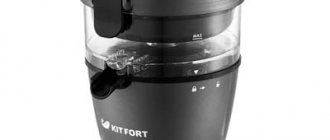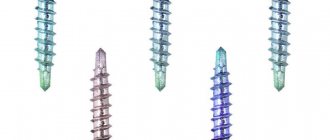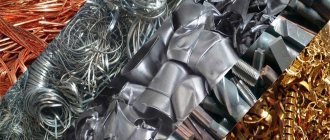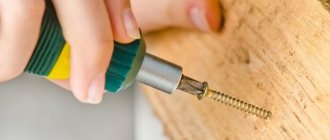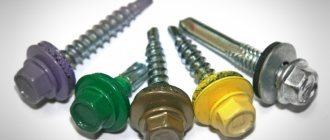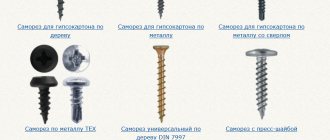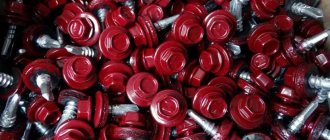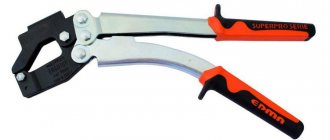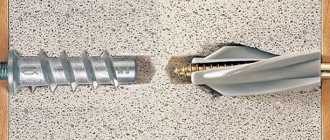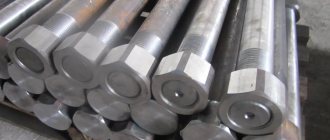Author of the article:
Self-tapping screws with a press washer are self-screwing fasteners designed for reliable connection of solid products. These hardware are used for working with concrete, wood, metal, and for fixing sheet materials of different textures and densities. Examples of using self-tapping screws with a press washer:
- for the manufacture of structures from metal sheets and metal profiles;
- for connecting wooden slats, bars and other lumber;
- in construction for installation of drywall, sandwich panels, insulation, decorative materials to the base or to the frame;
- in instrument engineering, electrical engineering and radio engineering;
- production of furniture, interior items;
- installation of gypsum decorative elements on a wall made of concrete, brick, aerated concrete or other material.
Hardware is affordable, and there is a wide range of standard sizes for working with different materials. Self-tapping screws should be selected depending on the type of material and operating conditions of the hardware.
Description of self-tapping screws with press washer
Fine thread fasteners are versatile, durable and affordable. Other characteristic features of self-tapping screws with a press washer:
- hardware is protected from corrosion and has a long service life;
- fastening strength is ensured by fine threads and a press washer, which prevents spontaneous loosening of the hardware;
- Due to the wide shape of the cap, the material to which the self-tapping screw is attached is not pressed through.
Self-tapping screws are made of carbon and stainless steel, as well as brass. Carbon steel hardware is characterized by increased strength and is suitable for making highly loaded connections. Stainless steel fasteners are universal and resistant to precipitation, high humidity and vibration loads. Brass screws are considered the most wear-resistant. The color of the self-tapping screws with a press washer depends on the color of the galvanized protective coating (yellow or white). Galvanized fasteners do not spoil the appearance of the products being fastened and do not require additional painting.
The hardware installation process is extremely simple. There is no need to prepare a hole for installation; the procedure looks like this:
- mark the installation point of the self-tapping screw on the surface of the material;
- press the hardware to the marked point, pierce a hole (if the tip of the product is sharp enough and the base material gives way);
- Using a screwdriver or screwdriver, tighten the hardware.
Self-tapping screws for the bugs profile. Option 2 - self-tapping screws with a press washer
Such self-tapping screws for drywall profiles are used in the same way as bugs. But this type of product has a number of differences:
| Illustration | Description |
| They have a wide cap. It is much lower than that of the first type of product and has a larger width - 10 mm or more. Thanks to this, the element is pressed tightly against the surface and creates less interference when installing sheets. | |
| They can have a length from 13 to 80 mm. But if you use them as self-tapping screws for a drywall profile, then there is no point in screwing in long elements; 13-16 mm is quite enough. | |
| They can have either a sharp or a drill tip. As in the first case, I recommend using sharp fasteners as they are more convenient and provide high strength. In addition, products with a drill are more expensive, so you will incur extra costs. | |
| They can have a galvanized or oxidized coating. Most often, shiny elements are found, but if you come across black fasteners, it’s okay, the quality does not deteriorate from this. |
It’s up to you to decide which screws to use to attach the drywall profile. I will only note that products with a press washer are much more expensive than bedbugs, and there is not much difference in connection reliability.
Below is a table of the ratio of weight and quantity; it contains both options for self-tapping screws for the frame. It will help you make accurate calculations, since fasteners can be sold both by weight and by quantity.
What bit is needed for self-tapping screws with a press washer?
Hardware of this type has a head for a Phillips screwdriver. Cross holes are divided into two types: for a regular cross you need a Ph bit, for a cross with characteristic notches between the edges at 45 degrees you need a Pz type bit. The Ph bit is versatile; it can be used to tighten cross-head screws of both types. It should be taken into account that when screwing in a self-tapping screw with a cross type Pz, the Ph bit does not fit tightly, but with a gap. However, it is possible to tighten the Pz hardware with its help.
There are 4 standard sizes of bits, they are designated from 0 or from 1 to 4. The Ph2 bit is most often used; it is suitable for self-tapping screws with an outer diameter of 3 to 5 mm. For hardware with a smaller diameter, you need a Ph1 bit; for self-tapping screws with a diameter of 6 mm, you need a Ph3 bit. The bit must be selected according to the size of the fastener, otherwise the bit will wear out faster. In addition, when using the wrong bit, the cross on the head of the hardware breaks off, which complicates unscrewing the screw in the future.
The diameter of the drill for self-tapping screws with a press washer depends on the material into which the fasteners are to be screwed. When working with metal, the drill is selected according to the thickness of the sheet. Drills with a diameter of 3.3 and 3.4 mm are most in demand when working with self-tapping screws.
Self-tapping screws for corrugated sheets - their types and classification
Self-tapping screws for fastening corrugated sheets are divided into several groups depending on their design, purpose and conditions of use. Self-tapping screws for corrugated sheets can be designed for attaching sheets to a frame made of wood or metal.
Self-tapping screws for corrugated metal have a finer thread and a special tip in the form of a drill. They are usually made from high-strength alloy carbon steel grade C1022 with a zinc protective coating. The presence of such a tip allows them to be screwed into a frame made of metal profiles without pre-drilling holes. So, self-tapping screws for corrugated sheets with a diameter of 4.8 mm can drill through metal 2.5 mm thick.
When attaching a profiled sheet to a wooden frame, self-tapping screws for corrugated wood are used. They have a large pitch cut and a sharp tip. In fact, they are distinguished from a regular screw only by a special head of increased diameter. But thanks to the strength of the steel from which they are made, such self-tapping screws can also pierce sheet metal up to 1.2 mm thick without pre-drilling. Usually this is sufficient for attaching corrugated sheets, since cladding and roofing profiled sheets, as a rule, have a thickness of 0.45 to 1.0 mm.
Self-tapping screws are also distinguished by the design of the head. It can be cylindrical, semicircular, spherical or hexagonal. The heads can also have various slots - asterisk, cross-shaped, figured or straight.
Self-tapping screws with hexagonal heads are designed specifically for fastening using a screwdriver or low-speed drill, since it is much easier to screw screws into corrugated sheets using power tools. In addition, the force needed to screw a self-tapping screw with such a head is six times less than for a self-tapping screw with a regular slot, and one and a half times less than for a self-tapping screw with a cross-head slot.
The type of self-tapping screws used to fasten the corrugated sheet also depends on the area of application of the metal profile. If for interior work and facade cladding you can use self-tapping screws with an enlarged head or press washer, then for roofing only self-tapping screws with an EPDM gasket are used. This is the name given to a special seal made of modified artificial rubber that seals the place where the corrugated sheeting is attached to the roof sheathing.
A gasket made of this material is glued to a spring metal washer and self-vulcanizes upon contact with the surface of the metal profile. This guarantees complete tightness of the attachment point and protects against the slightest penetration of moisture into the joint. At the same time, the gasket retains elasticity throughout the entire service life of the roofing and plays the role of a shock absorber, compensating for the expansion of the metal when the temperature of the roofing changes.
In addition to the sealing gasket, the roofing self-tapping screws along the edge of the hexagonal head have a special protrusion that strengthens the head and facilitates maximum pressing of the washer with a protective seal to the surface of the profiled sheet.
In addition to zinc, self-tapping screws for corrugated sheets can also have a colored protective and decorative coating. This allows you to choose which corrugated sheeting screws to use to attach profiles with different colors. Just like the metal profile itself, the screws are painted in the colors of the standard RAL palette, which allows you not to spoil the appearance of the roof, making its fastenings completely invisible.
Classification
Characteristics of self-tapping screws with a press washer:
- standard size (length, outer diameter of the head, thickness, thread pitch and other parameters of the self-tapping screw with a press washer);
- what alloy the fasteners are made of (steel, brass);
- sharp tip or drill.
Depending on the density of the materials to be fastened, choose self-tapping screws with a sharp tip or with a drill. Hardware with a sharp tip can be screwed in with a screwdriver or screwdriver without pre-drilling, if the density of the base allows it. Similar fasteners are used when working with wood, plywood, metal profiles and sheet metal. If the sheet metal thickness is more than 0.9 mm, you must first drill a hole for the self-tapping screw, otherwise the hardware will get stuck in the metal and will not pass through the material.
To fasten sheet steel with high strength values, self-tapping screws with a press washer and a drill at the end are used. Fasteners for metal must be denser than the material being joined, which is done when using hardware with a drill. For such fasteners, the head is often made in the shape of a hexagon. During the screwing process, more effort must be applied, and the strength of the cap must be ensured. For manual installation of self-tapping screws with a drill and press washer, use a wrench of the appropriate size.
Self-tapping screws are also classified into hardware for woodworking and metalworking. Wood screws have wider threads and a higher ridge. For wood species with high density, hardware with wavy or torn threads is used, which prevents the formation of cracks after screwing in the fasteners. Metal hardware is distinguished by smaller and often threaded threads, which ensure ease of installation and strength of the connection.
Another type of fastener is a roofing screw with a press washer. It has a drill and a hexagonal pressing head. To ensure the tightness of the connection with the hardware, use a rubber sealing washer. Since moisture resistance is of paramount importance for the longevity of the roof, a rubber gasket is necessary when making fastening connections. Roofing screws are produced with a colored polymer coating, which is resistant to mechanical stress, changes in humidity and ensures a long service life of the roofing material. The design of the self-tapping screw with a drill allows you to install fasteners without pre-drilling.
What screws are needed for the profile. Self-tapping screws for connecting profiles and hangers
Let's figure out what screws are needed for the profile? Metal screws are divided into 2 types. Each is different in its technical capabilities and is designed to perform specific functions.
Difference in screw usage
It should be noted here that it is possible to use self-tapping screws with or without a drill. The choice will depend on the quality of the profiles. Screws hold better without a drill, but it’s a little hard to screw them through two profiles, but for fastening hangers it’s perfect.
Self-tapping screws for installing drywall
REPAIR AND FINISHING IN ULYANOVSK - https://www.youtube.com/user/themostfamousMASTER A common problem when installing gypsum boards...
Screw with press washer
Among the craftsmen there are such names for screws as “seeds”, “bugs”. They are small in size, used for fixing profiles to each other and are the most popular.
The self-tapping screw for gypsum plasterboard is coated with either galvanized or oxidized coating. Despite the different tips, the functionality of the fasteners is the same. In order to install these self-tapping screws, no preliminary preparation is required. They are easily installed using a screwdriver or drill. The thin tip quickly makes a hole and by applying slight pressure on the screw, it is tightly fixed in the profile.
To save screws and quickly install, use a profile cutter.
With its help, such self-tapping screws are used to firmly fix the profile to the sheathing or fix metal hangers. It is allowed to work with a screw without pre-drilling holes. The thin tip pierces the base of the material, and the caps tightly fix the screwed elements. The most popular self-tapping screw sizes for fixing structures and conventional profiles with a length of 13-16mm.
Regular self-tapping screw with press washer
Self-tapping screw with drill and press washerDimensions, quantity and weight
Phosphated tapered screws
Distinctive features of the head:
- If the tool comes off on the screw head, it is impossible to get hurt - it is rounded;
- It is convenient to press the self-tapping screw during installation with a screwdriver or screwdriver;
- With such cooking, in some cases it is possible to use a washer or gasket;
- The cylindrical shape guarantees reliable fixation.
Table of size and weight of self-tapping screws with press washer
The dimensions and weight of self-tapping screws with a press washer, depending on the type of tip, are presented in the table:
| Size, designation | Weight, kg per 1000 pcs., sharp tip | Weight, kg per 1000 pcs., drill |
| SMM 4.2×13 | 1,4 | 1,75 |
| SMM 4.2×14 | 1,52 | 1,79 |
| SMM 4.2×16 | 1,6 | 1,94 |
| SMM 4.2×19 | 1,84 | 2,12 |
| SMM 4.2×25 | 2,23 | 2,50 |
| SMM 4.2×32 | 2,65 | 2,94 |
| SMM 4.2×41 | 3,25 | 3,6 |
| SMM 4.2×51 | 4,22 | 4,26 |
| SMM 4.2×76 | 5,16 | 5,68 |
Conclusion
Of course, there are other types of metal screws. However, whatever type of screws you choose, buy them only from trusted manufacturers to avoid unpleasant surprises. If you buy hardware from a store, ask for quality certificates. Well, the best option is to purchase fasteners from TsKI, since we carry products only from reliable suppliers and test each item in the laboratory.
Write to us and share your practical experience on using self-tapping screws for metal!
Did you like the material?
comments powered by HyperComments

